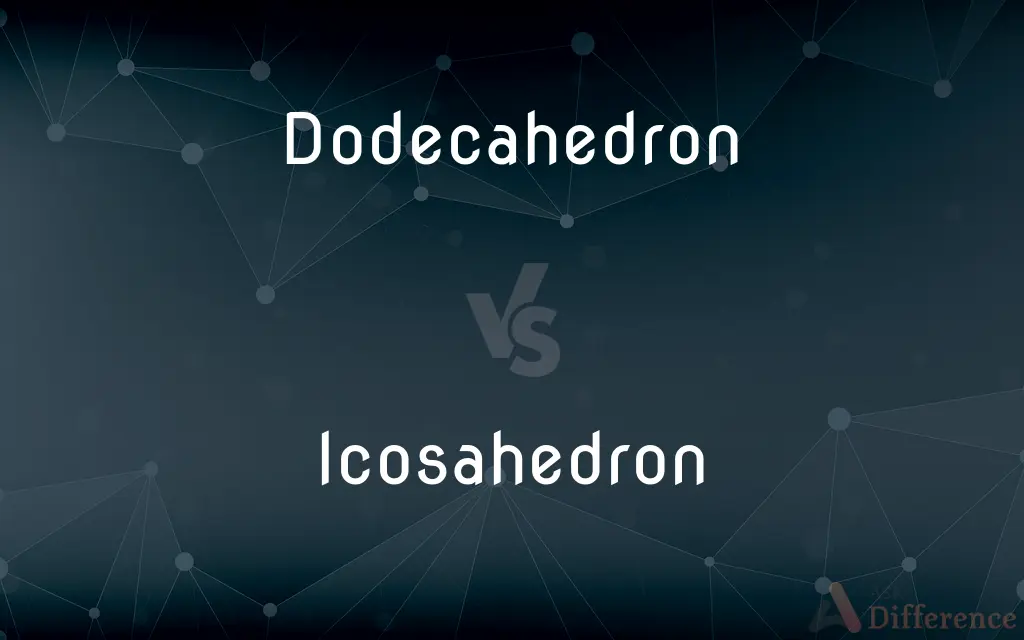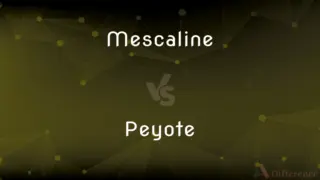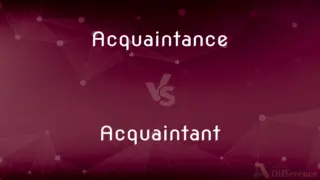Dodecahedron vs. Icosahedron — What's the Difference?
By Maham Liaqat & Urooj Arif — Updated on March 31, 2024
A dodecahedron is a polyhedron with 12 faces, each of which is a regular pentagon, while an icosahedron has 20 faces, each being an equilateral triangle. The dodecahedron symbolizes stability; the icosahedron, dynamism.

Difference Between Dodecahedron and Icosahedron
Table of Contents
ADVERTISEMENT
Key Differences
A dodecahedron is characterized by its 12 flat faces, with each face being a regular pentagon. This shape is one of the five Platonic solids, known for its aesthetic symmetry and mathematical beauty. The vertices and edges of a dodecahedron are arranged such that three faces meet at each vertex, making it a model of geometric perfection and stability. In contrast, an icosahedron has 20 faces, each one an equilateral triangle, and is another Platonic solid. With five triangular faces meeting at each of its 12 vertices, the icosahedron represents a more complex form of symmetry and is often associated with water and fluidity, reflecting its more dynamic nature.
The construction of a dodecahedron involves the assembly of 12 pentagonal faces, 30 edges, and 20 vertices. This geometric figure is often used in the design of dice, architectural details, and in various art projects due to its aesthetically pleasing form and symbolic representation of the universe. The icosahedron, with its 20 triangular faces, 30 edges, and 12 vertices, showcases a higher degree of complexity and is used in similar contexts but is particularly noted for its appearance in natural forms, including viral structures and radiolaria, highlighting its dynamic and fluid characteristics.
While both shapes are celebrated for their symmetry and mathematical properties, they serve different symbolic purposes in philosophical and scientific contexts. The dodecahedron is often associated with the universe and ether, suggesting a sense of cosmic order and stability. The icosahedron, however, is linked to water and fluid dynamics, symbolizing movement, change, and the flow of life. These associations stem from ancient philosophies that ascribed elemental properties to geometric shapes.
The differences between a dodecahedron and an icosahedron extend beyond their visual and structural aspects to their implications in mathematics and geometry. The dodecahedron, with its pentagonal symmetry, offers a model of balance and proportion, making it a subject of study in fields related to geometry and architectural design. On the other hand, the icosahedron, with its triangular facets, serves as a basis for studying topology and the geometry of complex shapes, including those found in nature, from microscopic organisms to the crystalline structure of certain minerals.
While both the dodecahedron and icosahedron are celebrated for their geometric beauty and symmetry, they represent different aspects of mathematical perfection and natural phenomena. The dodecahedron stands as a symbol of stability and cosmic order, while the icosahedron embodies dynamism and the complexity of the natural world.
ADVERTISEMENT
Comparison Chart
Faces
12 regular pentagons
20 equilateral triangles
Vertices
20
12
Edges
30
30
Symmetry
3 faces meet at each vertex
5 faces meet at each vertex
Symbolism
Stability, cosmic order
Dynamism, fluidity, change
Mathematical Interest
Geometric perfection, architectural design
Topology, natural phenomena modeling
Philosophical Association
Universe, ether
Water, fluid dynamics
Usage
Dice, architectural details, art
Viral structures, natural forms, art
Compare with Definitions
Dodecahedron
Used in geometric and architectural studies.
The architect incorporated dodecahedron elements into the structure.
Icosahedron
Has 12 vertices and 30 edges.
Five equilateral triangles meet at each vertex of the icosahedron.
Dodecahedron
Has 20 vertices and 30 edges.
Each vertex of the dodecahedron is shared by three pentagons.
Icosahedron
A polyhedron with 20 triangular faces.
The viral capsid resembles an icosahedron.
Dodecahedron
Symbolizes stability and cosmic order.
In ancient times, the dodecahedron represented the universe.
Icosahedron
Used in studies of topology and geometry.
The icosahedron plays a crucial role in the study of geometric topology.
Dodecahedron
Associated with ether in classical elements.
The dodecahedron is often linked to the concept of ether.
Icosahedron
Represents dynamism and fluidity.
The icosahedron is symbolic of water in philosophical texts.
Dodecahedron
A polyhedron with 12 pentagonal faces.
The puzzle's design is based on a dodecahedron.
Icosahedron
Found in natural phenomena modeling.
Scientists use the icosahedron to model complex natural structures.
Dodecahedron
A polyhedron with 12 faces.
Icosahedron
A polyhedron having 20 faces.
Dodecahedron
In geometry, a dodecahedron (Greek δωδεκάεδρον, from δώδεκα dōdeka "twelve" + ἕδρα hédra "base", "seat" or "face") or duodecahedron is any polyhedron with twelve flat faces. The most familiar dodecahedron is the regular dodecahedron with regular pentagons as faces, which is a Platonic solid.
Icosahedron
In geometry, an icosahedron ( or ) is a polyhedron with 20 faces. The name comes from Ancient Greek εἴκοσι (eíkosi) 'twenty' and from Ancient Greek ἕδρα (hédra) ' seat'.
Dodecahedron
(geometry) A polyhedron with twelve faces; the regular dodecahedron has regular pentagons as faces and is one of the Platonic solids.
Icosahedron
A polyhedron with twenty faces.
Dodecahedron
A solid having twelve faces.
Icosahedron
A regular icosahedron: one of the Platonic solids, all of whose faces are regular (equilateral) triangles
Dodecahedron
Any polyhedron having twelve plane faces
Icosahedron
A solid bounded by twenty sides or faces.
Icosahedron
Any polyhedron having twenty plane faces
Common Curiosities
Can both dodecahedrons and icosahedrons be found in nature?
Yes, both shapes appear in natural phenomena, from crystal structures to viral capsids.
How do the dodecahedron and icosahedron relate to Platonic solids?
They are both Platonic solids, representing idealized forms of symmetry and geometric perfection in classical philosophy.
What are the practical applications of dodecahedrons and icosahedrons?
They are used in various fields, including architecture, art, mathematical modeling, and even in game design as dice.
How do the vertices of dodecahedrons and icosahedrons compare?
The dodecahedron has 20 vertices, while the icosahedron has 12, despite both having 30 edges.
Why is the icosahedron associated with water?
Its fluid, dynamic structure, represented by 20 equilateral triangles, symbolizes water and change.
Can the dodecahedron and icosahedron be transformed into each other?
While they cannot be directly transformed due to their distinct geometric properties, both share a relationship through duality in Platonic solids, where the vertices of one correspond to the faces of the other and vice versa.
What role do these shapes play in mathematical education?
They serve as fundamental examples to teach symmetry, geometry, and the concept of Platonic solids, enriching students' understanding of mathematical beauty and structure.
What is the significance of the edges being the same number in both shapes?
Despite their different appearances, the equal number of edges highlights a deep mathematical symmetry and interconnectedness between these Platonic solids.
What makes a dodecahedron unique among polyhedra?
Its uniqueness lies in its 12 faces of regular pentagons, symbolizing stability and cosmic order.
How does the symbolism of these shapes impact their study and application?
The symbolic meanings attributed to these shapes throughout history enrich their study and application, blending mathematical, philosophical, and artistic perspectives.
Share Your Discovery

Previous Comparison
Mescaline vs. Peyote
Next Comparison
Acquaintance vs. AcquaintantAuthor Spotlight
Written by
Maham LiaqatCo-written by
Urooj ArifUrooj is a skilled content writer at Ask Difference, known for her exceptional ability to simplify complex topics into engaging and informative content. With a passion for research and a flair for clear, concise writing, she consistently delivers articles that resonate with our diverse audience.














































